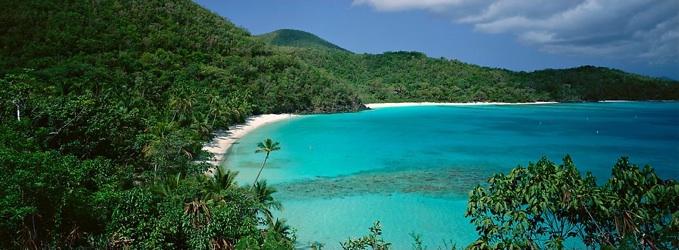Snorkeling Virgin Islands National Park
- By Kurt Repanshek - August 23rd, 2024 4:49am
Help power the National Parks Traveler’s coverage of national parks and protected areas.

Virgin Islands National Park, copyright QT Luong, www.terragalleria.com/parks
I celebrate the splendor and variety of the natural and human heritage with my photography. For the past twenty-five years, I have been privileged to travel, trek, and climb in some of the most remote and beautiful corners of the earth. Laying down in a colorful meadow dense with wildflowers, clinging precariously to a vertical icy mountain face, listening to the silence of desert sand dunes or to the calls of a bustling floating market might seem like very different experiences, however, I feel that they share the same life-affirming benefits.
For more of Tuan's work, visit www.terragalleria.com/parks
Beaches sparkling white and palm-lined. Warm Caribbean waters tinted turquoise and flecked with darting blue tangs, schools of yellow sergeant majors, and luminescent green parrot fish. Coral reefs swaying in the currents with their fans and given depth and texture by brain, staghorn, and elkhorn corals. These make this national park a tropical paradise.
It is one with a rich, at times dark, history with chapters that delve into slavery and pirating, a history whose stories reside in the ruins of sugarcane plantations that once covered the island of St. John, in bays and coves that were visited by pirates, in rock faces into which petroglyphs were hammered by ancient cultures. These are vignettes from the past that, when threaded together, help tell the story of European domination of paradise, of lost cultures and their beliefs, of a landscape that might have been found in Robert Louis Stevenson's Treasure Island.
Today the island with its national park is a fount of relaxation and rejuvenation, with more than a little fun mixed in. While nearby St. Thomas might be the cruise capital of the U.S. Virgin Islands, St. John is where you head to flee most of the throngs of tourists.
Though it covers only about 7,000 acres (2,833 hectares) on St. John, an island that itself covers only about 20 square miles (51.8 sq km), the national park seems to go on and on, no doubt in part because of the lack of roads. Cruz Bay is the "big city" on the island, and where your ferry ride from St. Thomas ends. It's a small town with narrow streets crowded with tourists and locals and their rigs. It's also where you'll find park headquarters with its maps, guidebooks, and other tools for orienting yourself, and some great restaurants.
At the park's visitor center in Cruz Bay you can orient yourself through natural and cultural resources exhibits, including some on coral reefs and the fishes that inhabit them. Here, too, you can pick up field guides and other interpretive materials.
Beyond Cruz Bay, the park with its sparkling beaches and densely forested mountainsides awaits.
Traveler's Choice for: Snorkeling, swimming, sea kayaking, beaches, archaeology.
Fancy yourself a modern-day Robinson Crusoe? Pitch your tent at Cinnamon Bay, the only beach in the park with a public campground. Here you'll also find kayak rentals, a restaurant and...limited parking, so don't expect to drive up at noon and easily find a spot.
There are no lodges within the national park. As a result, most visitors either stay at a resort or rent a house.
Ahhh, the sun-kissed Caribbean. Is there a better place for a mid-winter's getaway than a place with sugar-sand beaches lined by palms and washed by warm turquoise waters that provide habitat for sea turtles the size of trunks, colorful fishes like blue tang and parrotfish, and menacing barracudaIf you don't think so, then Virgin Islands National Park is your destination. Here's Traveler's Checklist to negotiate a visit to St. John and the park.
Though daily high and low temperatures don't change much throughout the year at the park, there is a rainy season, one that could include hurricanes.
To explore modern-day history of the park, it's worth turning the calendar back to the 1950s when a Rockefeller -- not John D. Rockefeller Jr., but rather Laurence Spelman Rockefeller -- took a decided liking to the island of St. John.
A wealth of beaches makes Virgin Islands National Park an incredible destination for water lovers. Any of those beaches within the national park can quickly become a favorite to head to day after day after day during your visit, guaranteed to provide warm waters teeming with marine-life, soft, sugar-sand beaches lined by palms perfect for napping. And yet, beach hopping is encouraged, if only to explore what this park offers.
You won't go on terribly long hikes at Virgin Islands National Park, but there are some interesting options for when you want a day away from the beaches. One of the few trails of any significant length is Reef Bay, and though it's only about 3 miles (4.8 km) long, it's not to be looked down upon (unless you're hiking down it).
The Annaberg Plantation ruins are the best-preserved on the island, and a stop there is worth an hour or two at least. At the height of its operation, in the late-18th century, it was one of more than two dozen sugar plantations in production on St. John.
This is where you can find websites, helpful phone numbers, friends groups and cooperating associations, and, sometimes, books related to the park.


National Parks Traveler is a 501(c) (3) nonprofit.


Here’s the definitive guide to National Park System campgrounds where RVers can park their rigs.
Our app is packed with RVing- specific details on more than 250 campgrounds in more than 70 national parks.
You’ll also find stories about RVing in the parks, tips helpful if you’ve just recently become an RVer, and useful planning suggestions.
